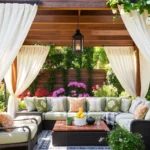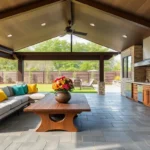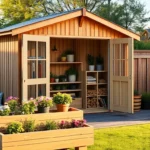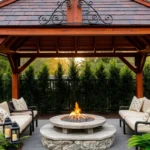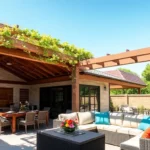Imagine stepping into your backyard, where the warmth of the summer sun is perfectly balanced by the cool shade of a beautifully designed patio shelter. Whether you’re a seasoned outdoor enthusiast or just beginning your journey in transforming your outdoor space, “14 Inspiring Patio Shelter Ideas for Summer” is your ticket to creating a stunning yet practical oasis. These ideas promise to elevate your outdoor living experience, offering a sanctuary that blends style with comfort.
From enhancing your entertainment options to providing a serene retreat, the benefits of a well-designed patio cover are endless. This guide is packed with innovative and achievable ideas that cater to all levels of expertise, ensuring you feel inspired and equipped to tackle your next outdoor project. Dive in and discover how you can effortlessly transform your patio into the envy of the neighborhood while enjoying the joyful rewards of your beautiful new space.
Add Retractable Awning for Flexibility
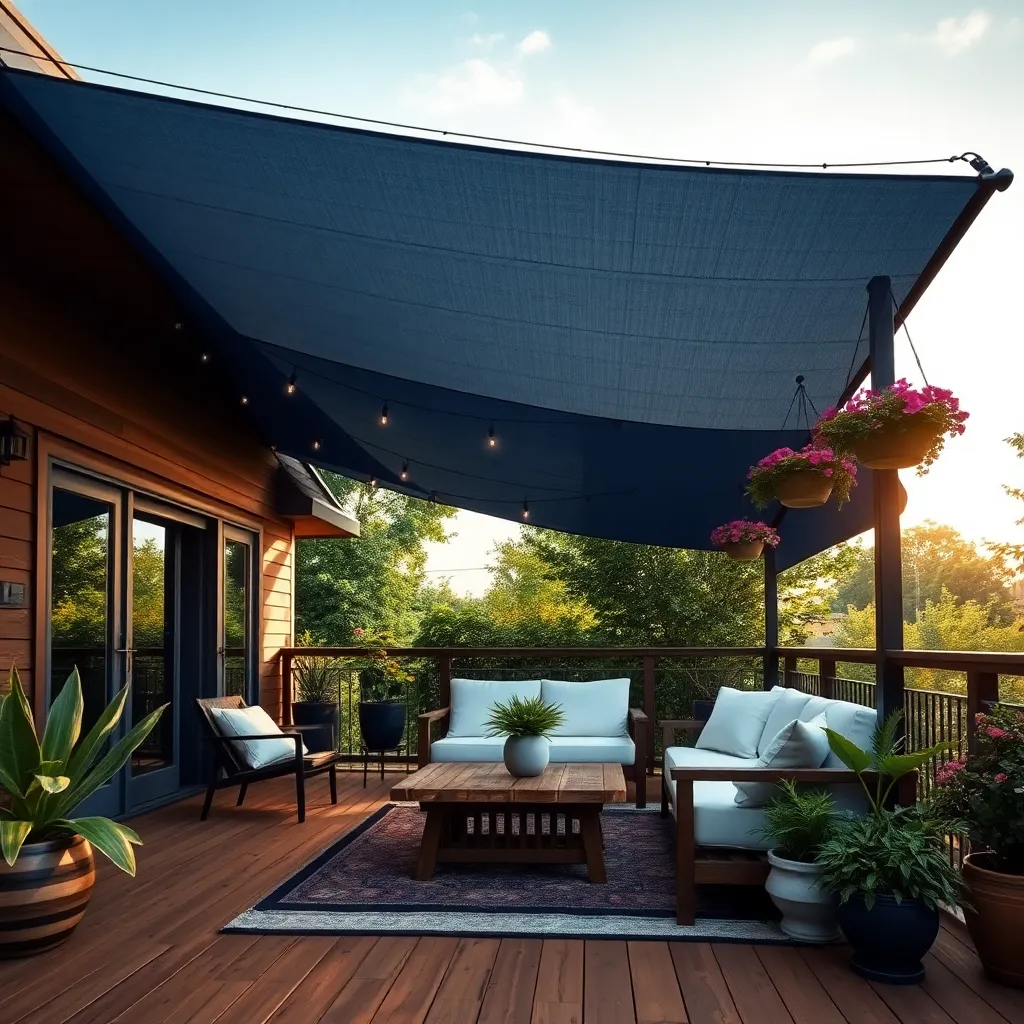
Installing a retractable awning adds tremendous flexibility to your patio, allowing you to enjoy both sun and shade at your convenience. Opt for materials like weather-resistant acrylic fabric that can withstand various elements and provide UV protection. For those new to home projects, consider a manual crank model, which is both budget-friendly and easy to install. To elevate your setup, experienced DIYers might explore motorized options that can be controlled via remote or smartphone, adding a touch of modern convenience to your outdoor space.
When selecting an awning size, measure your patio area accurately to ensure adequate coverage; a typical awning might extend 10 to 12 feet. Design elements such as coordinating the awning color with your exterior paint can create a cohesive look. For advanced tips, consider installing integrated LED lighting or side screens for added privacy and ambiance. Remember, a retractable awning is not just a shelter but a dynamic element that enhances the functionality and aesthetics of your outdoor living area.
Incorporate Pergola with Climbing Vines
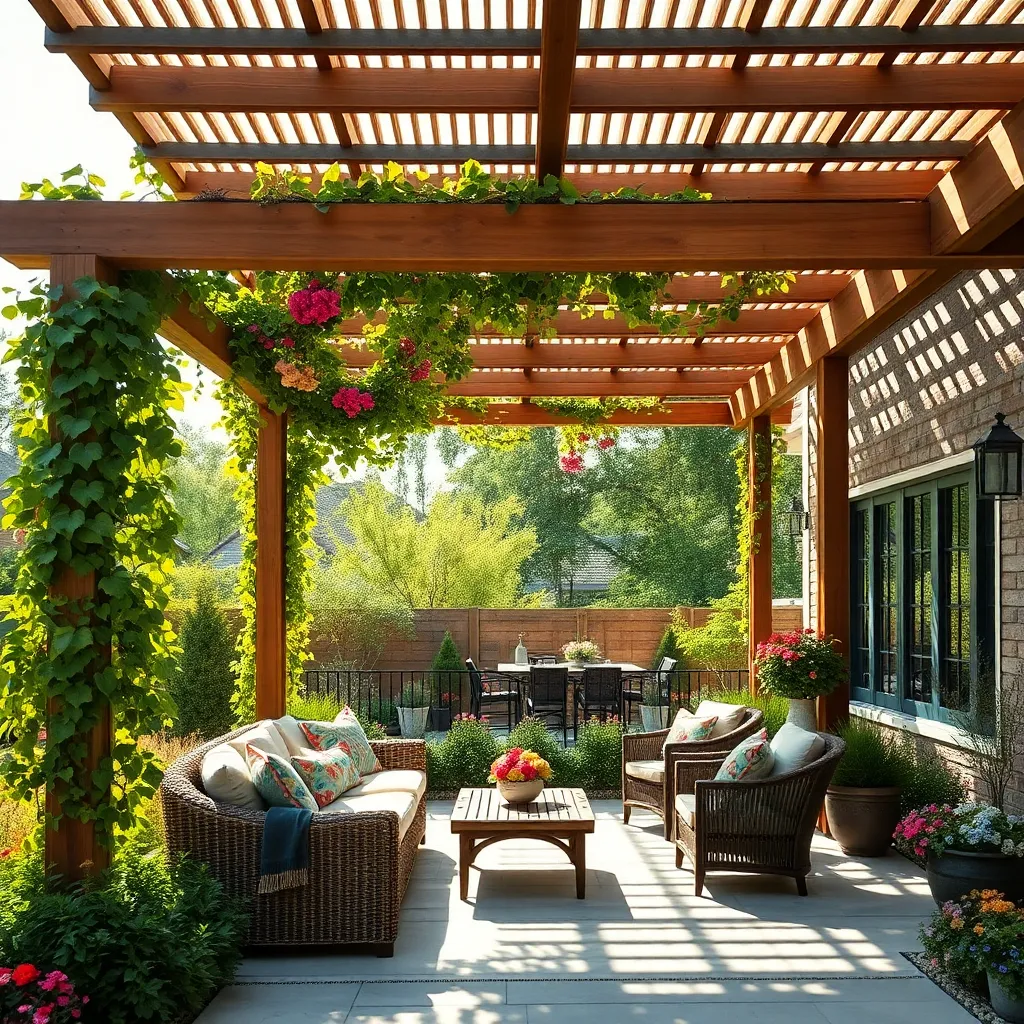
Incorporating a pergola with climbing vines can transform your patio into a serene, shaded oasis. Choose durable materials like cedar or pressure-treated wood for the pergola to ensure longevity and resistance to the elements. Beginners can start with fast-growing vines such as wisteria or clematis, which quickly provide lush coverage and a burst of color. For a more advanced touch, consider integrating a drip irrigation system to maintain moisture levels and encourage healthy vine growth.
Design your pergola with an open lattice top to allow vines to weave naturally, creating a picturesque canopy. Ensure your pergola is at least 8 feet tall to provide ample headroom and accommodate mature vines. For added elegance, incorporate integrated seating or a built-in bench along the perimeter. This not only maximizes relaxation space but also helps anchor the structure visually. With these thoughtful additions, your pergola will serve as both a functional shelter and a stunning focal point in your outdoor space.
Use Sail Shades for Modern Appeal
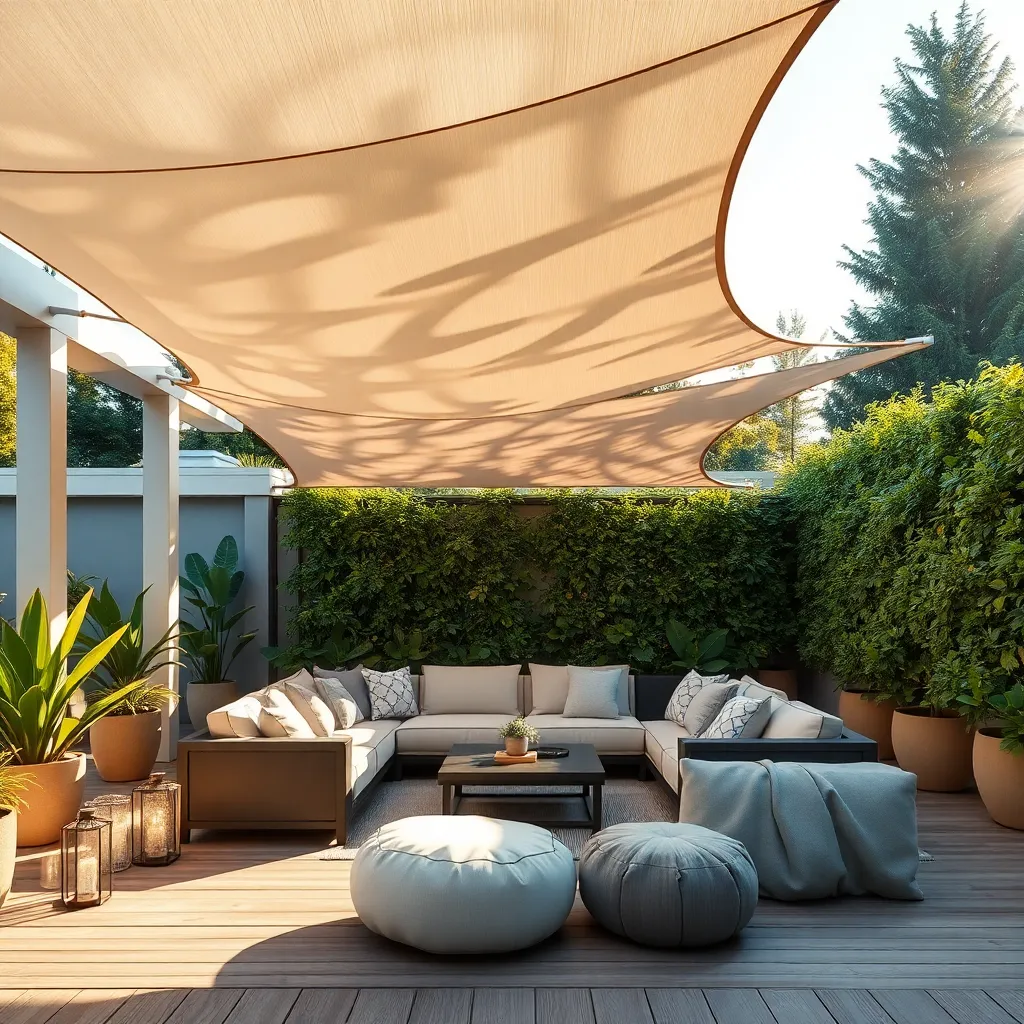
For a modern twist on outdoor shade, consider installing sail shades over your patio. These triangular or rectangular fabric canopies offer a sleek aesthetic while providing much-needed protection from the sun. Opt for UV-resistant materials, such as high-density polyethylene (HDPE), to ensure longevity and effective sun blocking. Installation can be a breeze—simply attach the sails to existing structures like walls or posts using sturdy hardware, ensuring they are taut to prevent sagging.
When choosing sail shades, experiment with different configurations by overlapping multiple sails for a dynamic and layered look. This not only enhances visual interest but also increases shaded areas. Advanced gardeners might explore motorized retractable options for added convenience and flexibility. Ensure you measure your space accurately, allowing for at least a 10% slope to encourage water runoff. With these tips, your patio can achieve both a stylish and functional transformation.
Install a Transparent Roof Covering
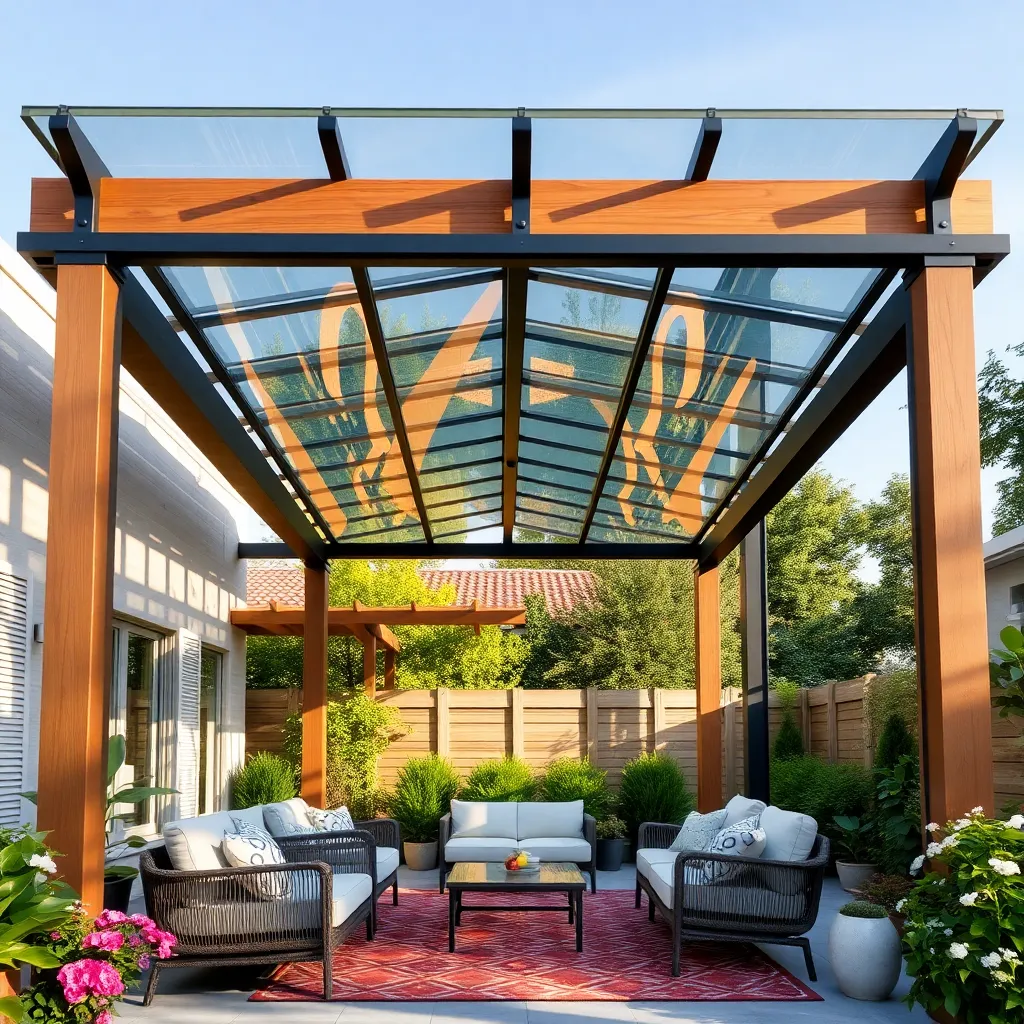
Consider installing a transparent roof covering to create a bright yet sheltered patio space. A polycarbonate roof is an excellent choice, offering UV protection while allowing natural light to filter through, creating a warm and inviting atmosphere. This material is lightweight yet sturdy, making it easy for both DIY enthusiasts and professionals to handle. Opt for a clear or slightly tinted polycarbonate to match your desired aesthetic, and ensure it fits securely to prevent leaks.
For a polished finish, use a metal or wooden frame to support your transparent roof. Choose materials that complement your existing outdoor decor for a cohesive look. When installing, ensure the roof is slightly sloped to facilitate water drainage, preventing pooling. Advanced DIYers can add gutter systems to direct rainwater away from the patio. This setup not only enhances the look of your outdoor space but also extends its usability through various weather conditions.
Create Bamboo Screen for Privacy
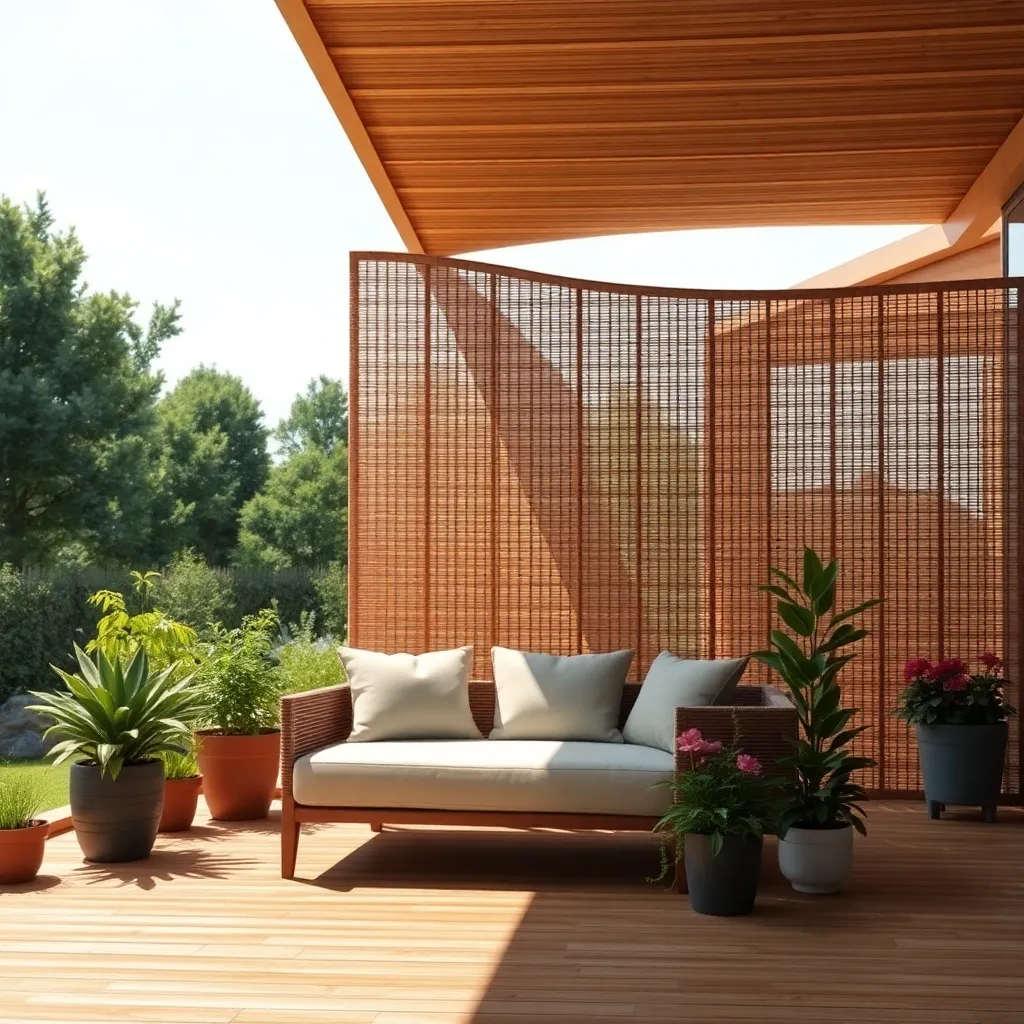
For an elegant and natural way to enhance privacy on your patio, consider creating a bamboo screen. Bamboo is an excellent choice due to its durability, sustainability, and quick growth. To start, purchase bamboo poles from a local garden center or online, ensuring they are at least 6-8 feet tall for adequate coverage. Position the poles closely together in a row along the edge of your patio, securing them with heavy-duty zip ties or wire to a sturdy frame or existing fencing. This simple setup not only provides privacy but also adds a touch of exotic charm to your outdoor space.
Beyond basic installation, you can personalize your bamboo screen to suit your style. Consider weaving in string lights for a cozy evening ambiance or attaching small planters for a vertical garden effect. For a more permanent solution, anchor the bamboo poles in concrete-filled planters for stability against wind. Ensure the screen is at least 2 feet taller than seating areas for optimal privacy. For those with a knack for DIY, try adding a water-resistant sealant to enhance the longevity of your bamboo screen, keeping it beautiful for many summers to come.
Hang Weatherproof Curtains for Shade

Adding weatherproof curtains to your patio shelter not only provides excellent shade but also introduces a stylish, versatile element to your outdoor space. Choose **durable, UV-resistant fabrics** like polyester or acrylic to ensure longevity and protection from the sun’s harsh rays. For beginners, installing a basic curtain rod system with grommeted curtains can be a straightforward project, while more advanced DIYers might prefer mounting a ceiling track system for a sleek, modern look.
When selecting curtain dimensions, consider the height and width of your patio structure to ensure ample coverage and a tailored fit. **Opt for curtains that are slightly wider than your space** to allow for a luxurious drape effect when drawn. To enhance functionality, consider incorporating tiebacks or outdoor curtain clips for easy adjustment and secure positioning during windy days. These simple yet impactful additions can transform your patio into a comfortable, shaded oasis perfect for summer lounging.
Build a Gazebo with Built-in Seating
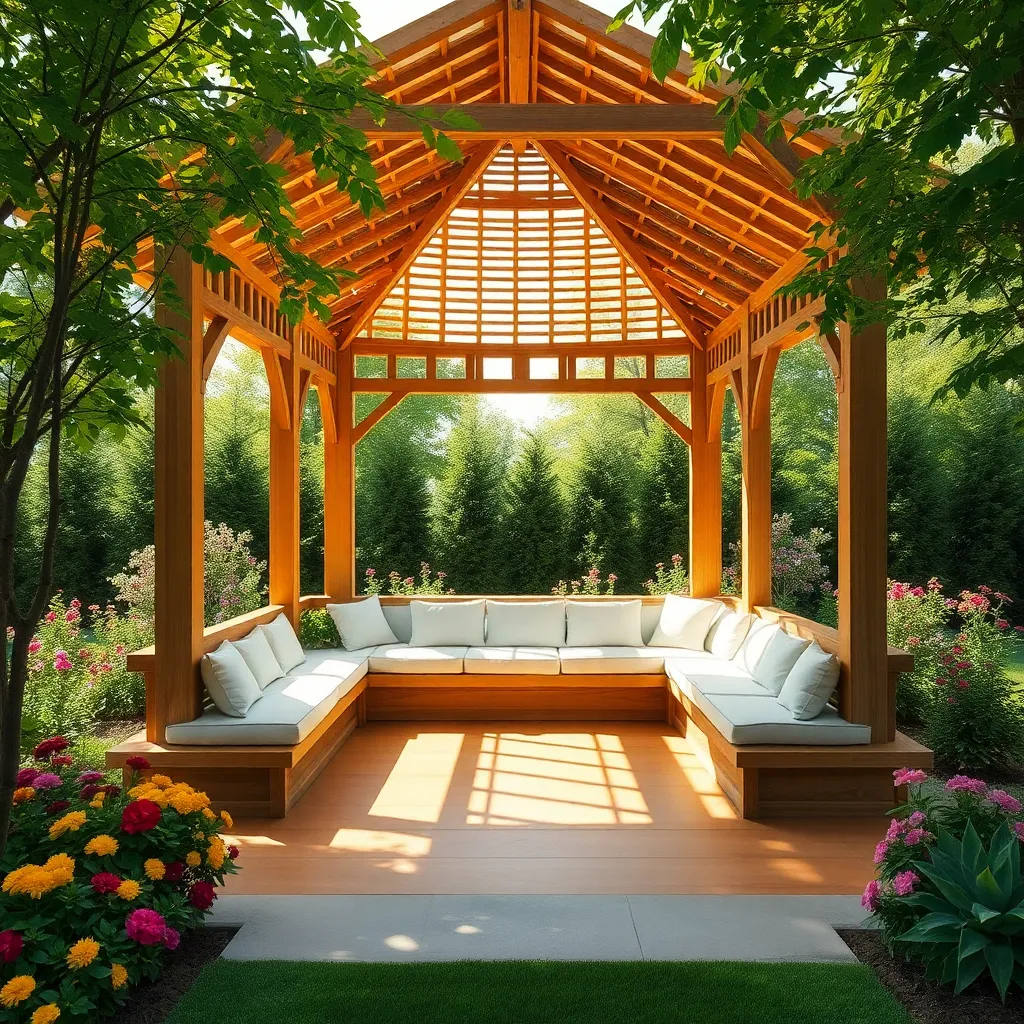
Creating a gazebo with built-in seating not only adds charm to your patio but also provides a cozy, functional space for gatherings. Start by selecting a durable material like cedar or pressure-treated wood, which can withstand summer weather. For beginners, a simple square or octagonal design is easiest to achieve, while more advanced builders might opt for intricate lattice work or a shingled roof. Ensure your gazebo is at least 10×10 feet to comfortably accommodate built-in seating around the perimeter.
For the built-in seating, use weather-resistant cushions and fabrics to enhance comfort and style. Incorporate storage options beneath the benches to maximize space and utility.
- Consider using treated lumber or composite materials for the seating to prolong its life.
- Advanced builders might integrate electrical outlets for lighting or fans within the structure.
With these thoughtful design elements, your gazebo will become a beloved retreat for family and friends.
Install a Slide-Wire Canopy System
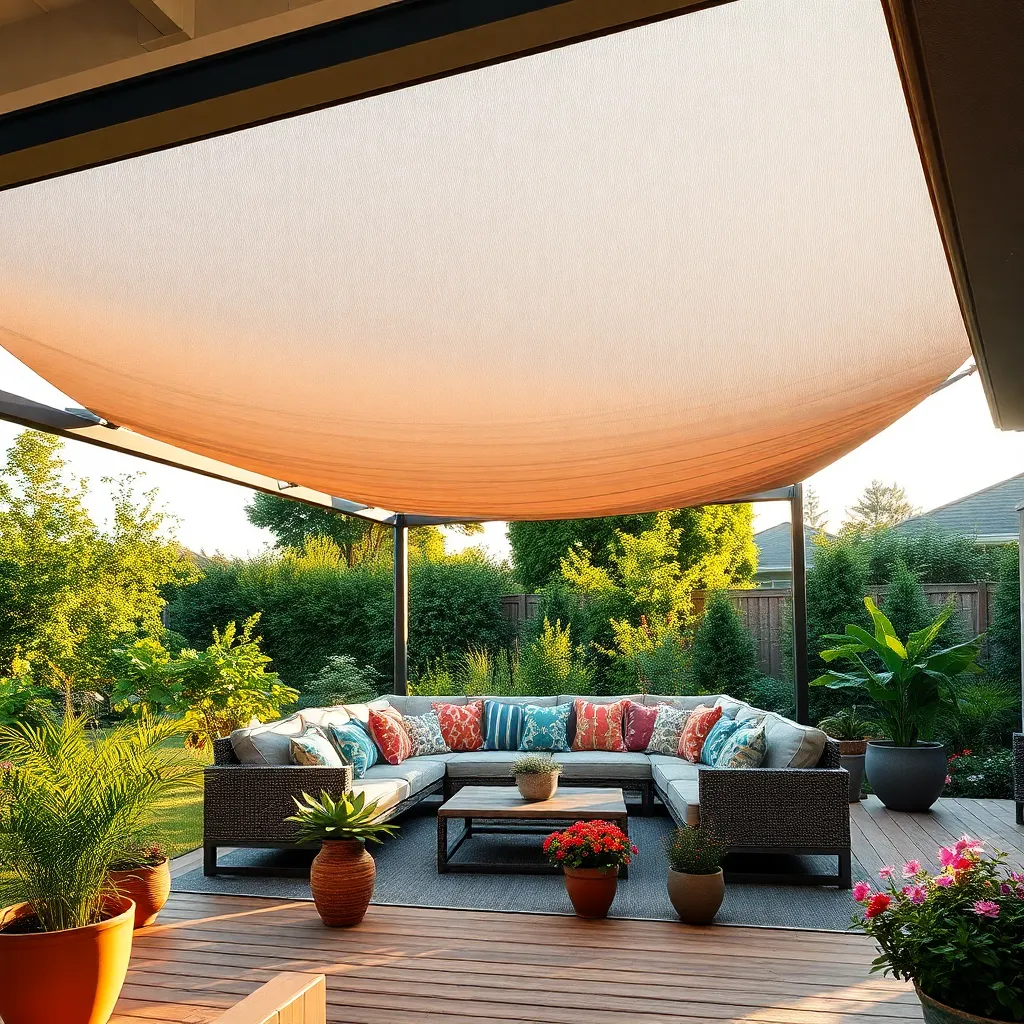
For an adaptable patio shelter, consider installing a slide-wire canopy system. This versatile option allows you to control the amount of sunlight and shade on your patio, making it perfect for varying weather conditions. Start by selecting a durable, weather-resistant fabric like acrylic or polyester, which can withstand outdoor elements. Use galvanized steel cables to support the canopy, as these resist rust and provide strong support. Ensure the cables are securely anchored to surrounding structures such as walls or posts, maintaining a slight slope for water runoff.
When planning your slide-wire canopy, calculate the dimensions of your patio to ensure full coverage. For a more polished look, choose a fabric color that complements your outdoor decor. Beginners should focus on a simple design, installing the canopy on a flat plane. For those with advanced DIY skills, consider incorporating a pulley system to adjust the canopy easily. Regular maintenance, like cleaning the fabric and checking cable tension, will prolong the system’s functionality and appearance. With these steps, you can create a charming and functional outdoor retreat that enhances your summer experience.
Construct a Rustic Wooden Pavilion
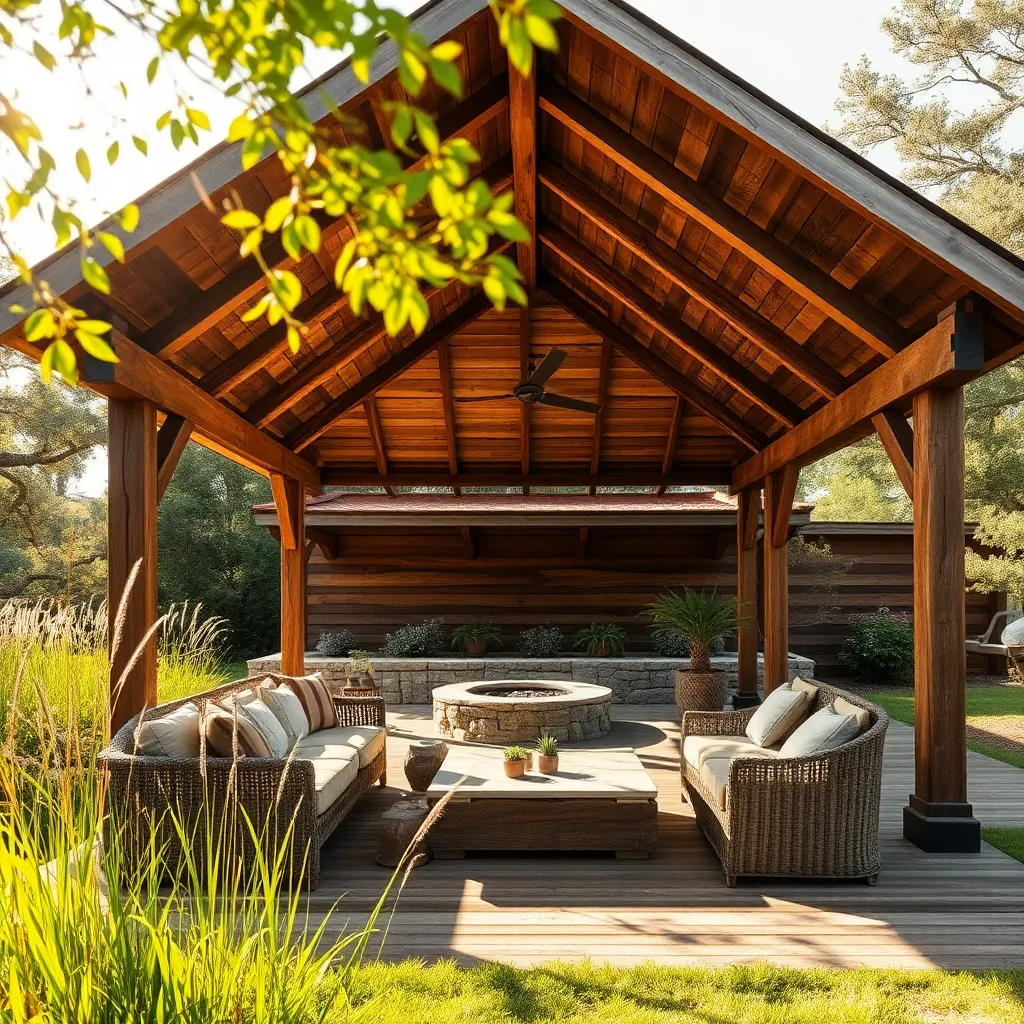
For a charming blend of function and style, consider constructing a rustic wooden pavilion. Begin by selecting durable woods like cedar or redwood, which are naturally resistant to insects and decay. Design your pavilion with a simple post-and-beam structure, typically requiring six to eight sturdy posts, depending on size. For a basic setup, aim for dimensions of around 12×14 feet to comfortably fit seating and a small table. Ensure the foundation is level and secure by setting the posts in concrete footings, which offer stability against the elements.
To enhance the rustic appeal, use rough-sawn timber and leave the wood untreated for a natural weathered look. Consider adding a slatted roof to let in dappled sunlight while providing shade. Incorporate design elements like decorative braces or cross beams for added visual interest and stability. For those with advanced skills, installing a ceiling fan or string lights can add functionality and ambiance. Remember, a well-constructed pavilion not only shelters but also becomes a beautiful focal point in your outdoor space.
Mount Adjustable Louvered Roof Panels
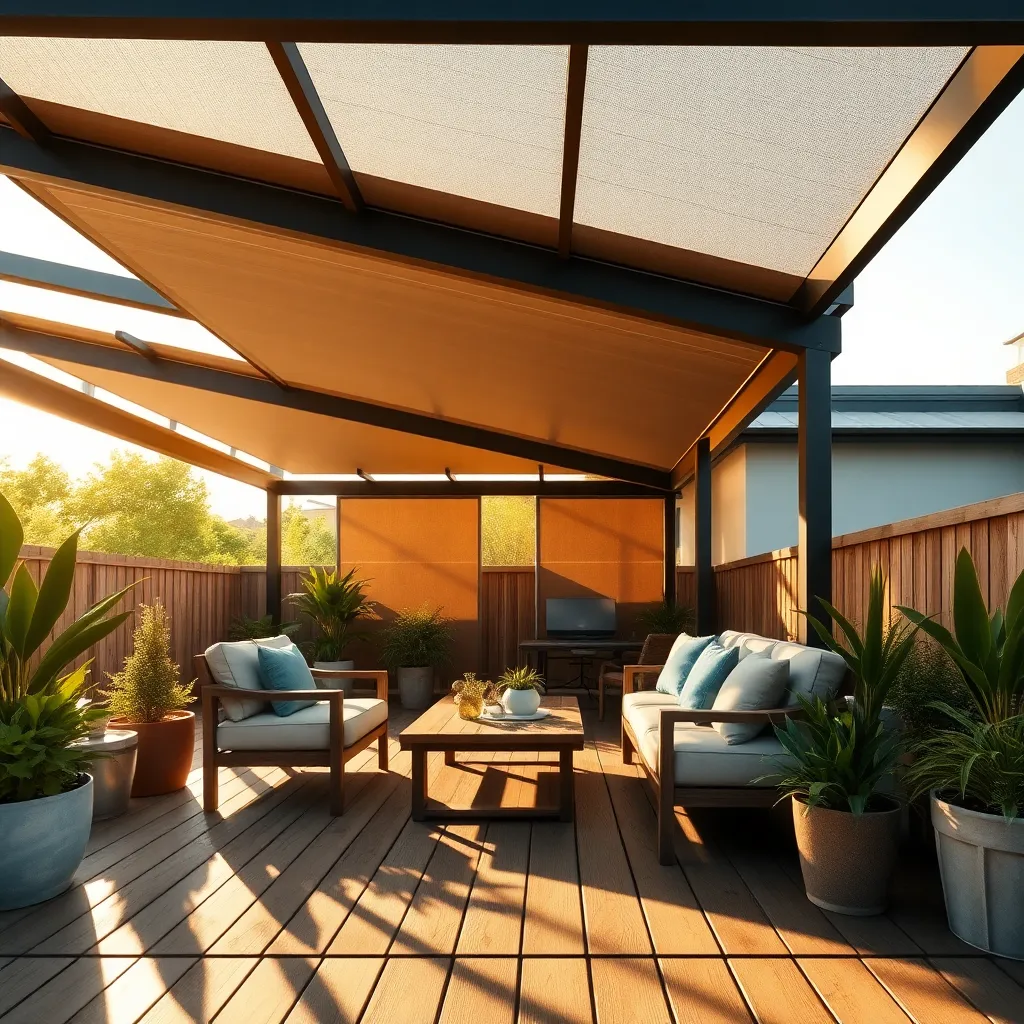
Enhance your patio with adjustable louvered roof panels, offering a flexible shelter solution that adapts to various weather conditions. These panels allow you to control the amount of sunlight and ventilation by adjusting the angle of the louvers. Opt for materials like aluminum for durability and low maintenance, or wood for a more natural aesthetic. Beginners can consider pre-made kits that simplify installation, while those with more experience might explore custom-built options for a tailored fit.
For a seamless integration, ensure the panels complement your existing outdoor decor by choosing finishes and colors that match your patio furniture or house exterior. Consider incorporating additional features such as motorized controls for effortless adjustment at the touch of a button. Advanced users might also install rain sensors that automatically close the louvers during inclement weather, providing a convenient and weatherproof outdoor space. By investing in this versatile shelter, you’ll create a comfortable, adaptable patio environment perfect for any summer activity.
Design a Green Roof for Cooling
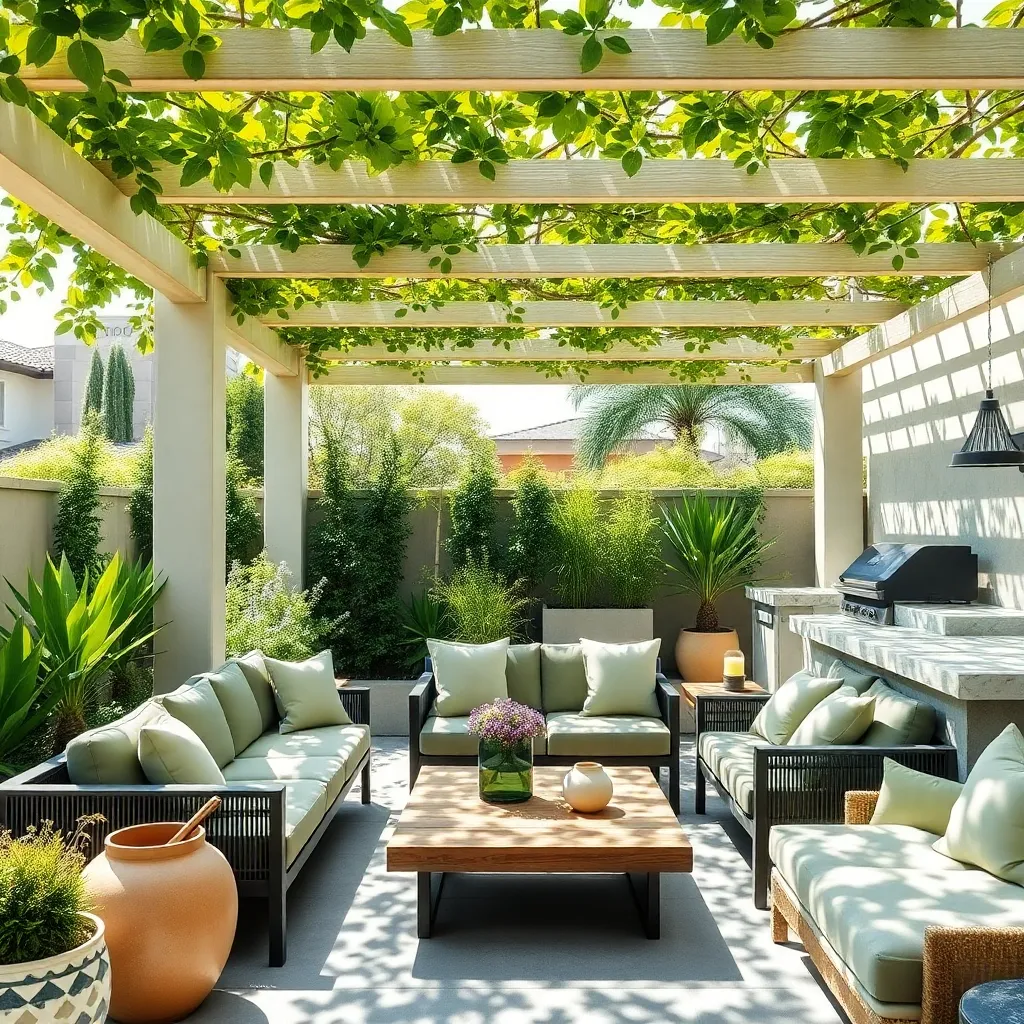
To design a green roof that cools your patio, start by ensuring your structure can support the additional weight of soil and plants. Use lightweight substrates like expanded clay or perlite mixed with compost to create a fertile base without compromising stability. Select hardy, drought-tolerant plants such as sedums and succulents that thrive in full sun and require minimal maintenance. These plants not only provide cooling shade but also improve air quality and biodiversity.
For beginners, a modular green roof system with pre-planted trays is an easy option to install and manage. Ensure adequate drainage by incorporating a waterproof membrane and drainage layer beneath the growing medium. Advanced gardeners might consider integrating a drip irrigation system to maintain consistent moisture levels during dry spells. With careful plant selection and thoughtful design, your green roof will become a sustainable and visually stunning feature of your outdoor space.
Fit Solar-Powered Umbrellas for Shade
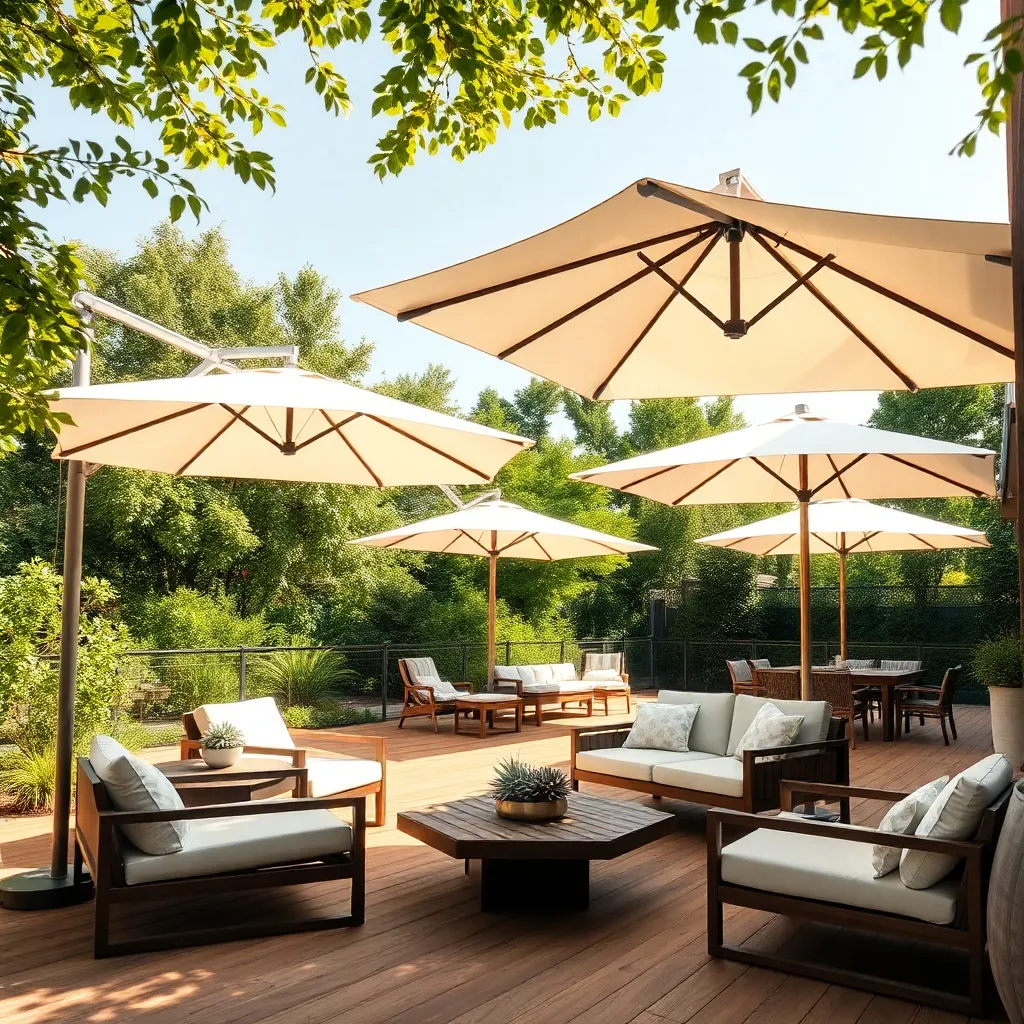
Enhance your patio experience by installing solar-powered umbrellas, which not only provide shade but also offer eco-friendly energy solutions. These umbrellas are equipped with solar panels on top, allowing them to power built-in LED lights, perfect for creating a cozy evening ambiance. When choosing your solar umbrella, opt for a model with a sturdy aluminum or steel frame for durability, and a UV-resistant fabric to ensure long-lasting protection from the sun.
For those seeking advanced functionality, some solar umbrellas come with USB ports to charge your devices, making them an excellent choice for tech-savvy homeowners. Consider an umbrella with a tilt-and-crank feature to easily adjust the shade coverage throughout the day. Ensure the umbrella is large enough to cover your desired area; typically, a 9 to 11-foot canopy will suffice for most patio tables. With the right solar umbrella, you can enjoy sustainable shade and enhanced outdoor comfort.
Utilize Pop-Up Canopies for Flexibility
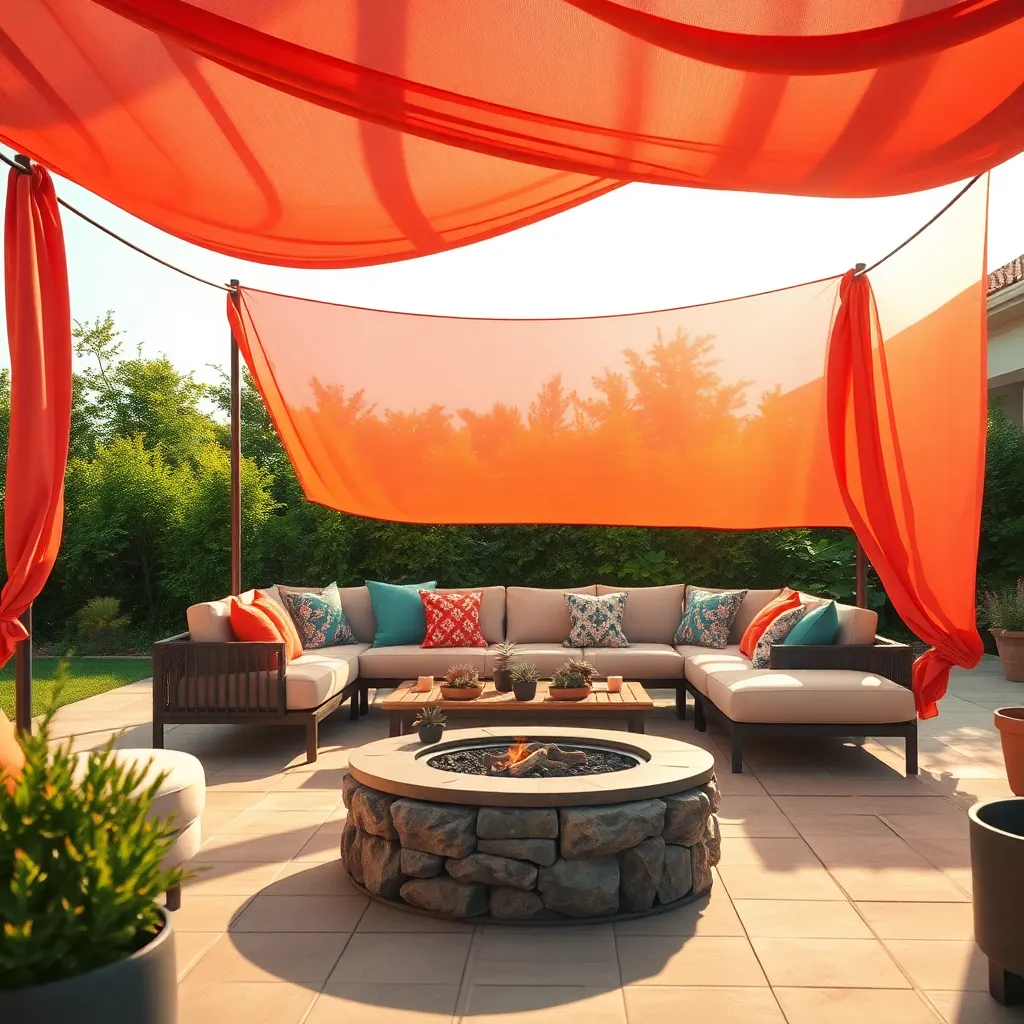
Pop-up canopies are an excellent choice for those seeking flexible and temporary shelter solutions on their patios. These canopies are available in various sizes, typically ranging from 8×8 to 10×20 feet, making them suitable for both small gatherings and larger events. When selecting a canopy, look for materials like polyester with a UV-resistant coating, ensuring durability and sun protection during those hot summer days. Their collapsible frames make them easy to set up and take down, offering convenience for homeowners who might need to frequently change their patio layout or store their shelter during off-seasons.
For a more personalized touch, consider customizing your pop-up canopy with sidewalls or netting to provide additional protection from wind or insects. Advanced gardeners or DIY enthusiasts can enhance their canopies by adding LED string lights or hanging plants from the frame for a cozy, inviting atmosphere. To ensure stability, use weighted sandbags or stakes, especially in windy conditions. This versatility allows you to create a comfortable and adaptable outdoor space that can be adjusted to suit any occasion or weather condition.
Implement a Tensioned Fabric Structure
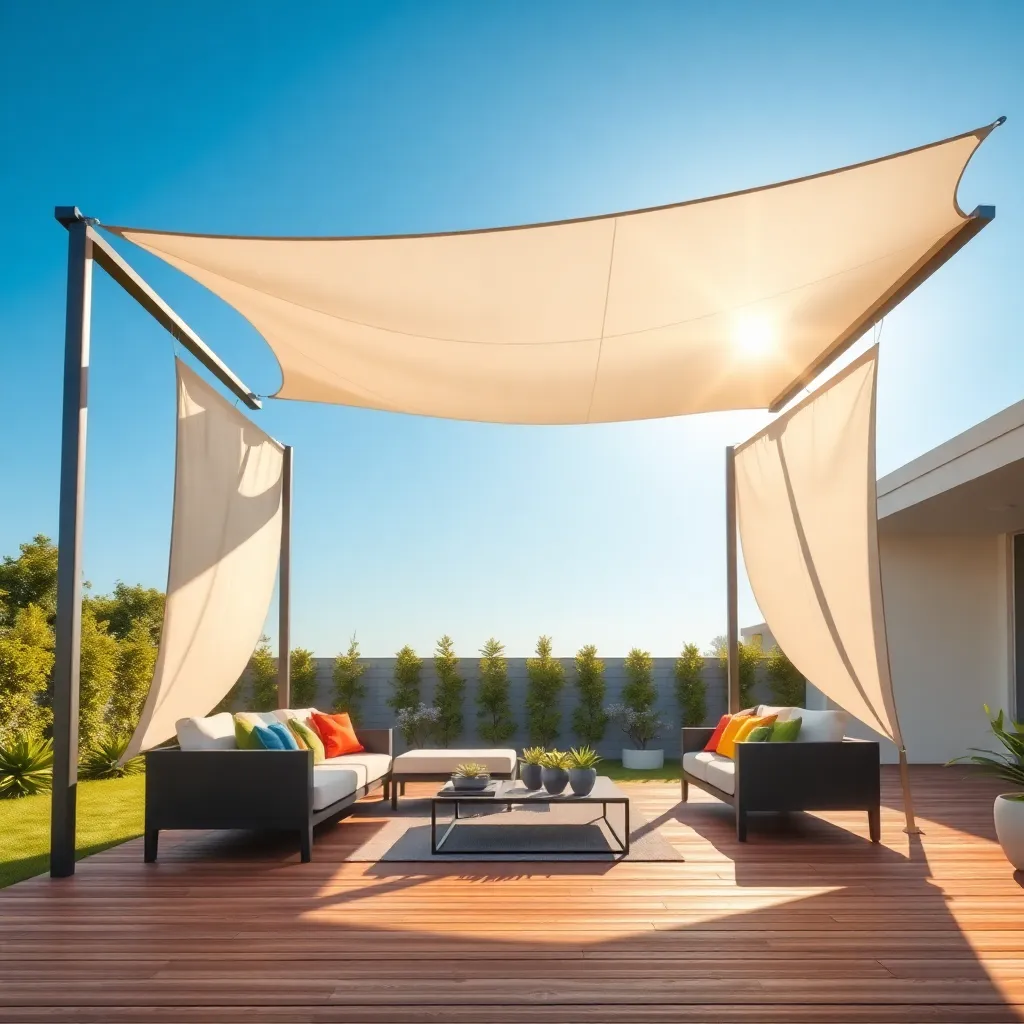
For a sleek and modern patio cover, consider implementing a tensioned fabric structure. These are ideal for creating a stylish and functional outdoor space, using materials like PVC-coated polyester or PTFE-coated fiberglass. The key advantage is their ability to provide extensive shade while maintaining an airy, open feel. Start with a basic framework, typically constructed from steel or aluminum, to ensure durability and longevity. Beginners can start with simple designs, while more experienced DIYers might experiment with dynamic shapes to add architectural interest.
Installation of a tensioned fabric structure requires careful planning and precision. Ensure that the fabric is tautly secured to prevent sagging and withstand weather conditions. Use adjustable tensioning systems to maintain the correct pressure on the fabric over time. For a personalized touch, choose fabrics in colors that complement your home’s exterior. When it comes to dimensions, tailor the structure to the size of your patio, ensuring ample coverage without overwhelming the space. Engage professionals for complex designs to achieve a flawless finish.
Conclusion: Creating Beautiful Outdoor Spaces
As we wrap up our journey through the ’14 Inspiring Patio Shelter Ideas for Summer,’ we’ve explored concepts like creating a welcoming space for connection, the importance of shared outdoor experiences, and the power of a serene environment to nurture communication. Each idea, from cozy pergolas to vibrant sun sails, serves as a metaphor for building strong, resilient relationships that thrive under any condition.
Now, take a moment to choose one idea that resonates with you and start planning how you can incorporate it into your summer space. Whether it’s setting up a romantic evening under a gazebo or hosting a family gathering beneath a shady trellis, the key is to create opportunities for meaningful interaction.
Don’t forget to bookmark this article for future inspiration as you continue to enhance your relationship with these simple yet profound ideas. With a little creativity and intention, your patio can become a haven of love and connection.
Remember, the seeds of today’s efforts will blossom into the thriving relationships of tomorrow. Your journey towards a more connected and fulfilling relationship begins today. Let’s make this summer unforgettable!


